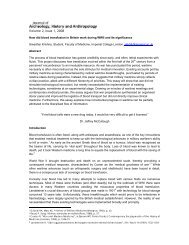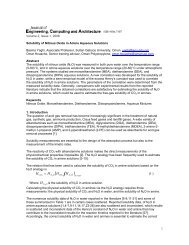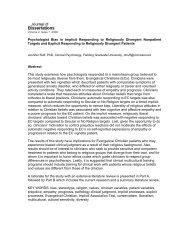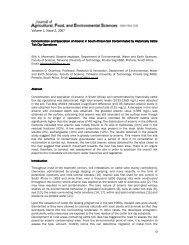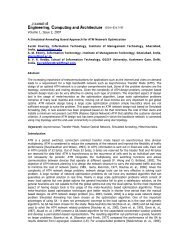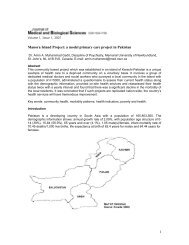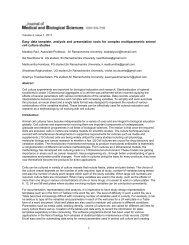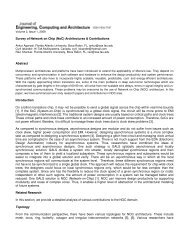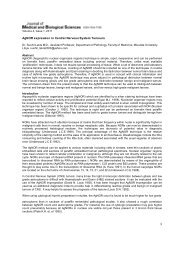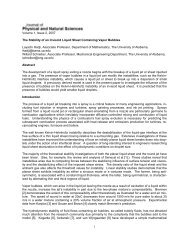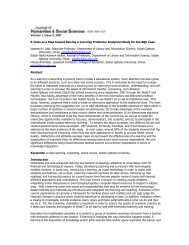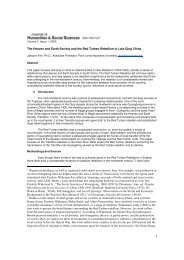Analyzing Data from a Regression Discontinuity Study - Scientific ...
Analyzing Data from a Regression Discontinuity Study - Scientific ...
Analyzing Data from a Regression Discontinuity Study - Scientific ...
Create successful ePaper yourself
Turn your PDF publications into a flip-book with our unique Google optimized e-Paper software.
Volume 2, Issue 1, 2008<br />
<strong>Analyzing</strong> <strong>Data</strong> <strong>from</strong> a <strong>Regression</strong> <strong>Discontinuity</strong> <strong>Study</strong>: A Research Note.<br />
Howard B. Lee, Professor of Psychology, California State University, Northridge,<br />
howard.lee@csun.edu<br />
Abstract<br />
The Chow Test (Chow, 1960) is a method well known in econometrics. It was originally designed<br />
to analyze the same variables obtained in two different data sets to determine if they were similar<br />
enough to be pooled together. The method, however, could be used to determine if two<br />
regression lines are different <strong>from</strong> one another. This article discusses the use of the Chow Test<br />
on data obtained in a regression discontinuity study.<br />
Introduction<br />
A seldom used quasi-experimental research design that is covered in a number of<br />
publications on research methodology such as Christensen (2006) and Kerlinger & Lee<br />
(2000) is the regression discontinuity design. A number of popular texts, however, do not<br />
mention this method (Graziano & Raulin, 1993; McGuigan, 1997). There are however, a<br />
number of documents available on the Internet discussing and using the regression<br />
discontinuity design.<br />
This design starts with a selection criterion that separates entities (people) into two groups on<br />
the basis of some measurement such as achievement or anxiety. This design then tests<br />
whether some intervention, treatment or program change alters the relation between the<br />
selection criteria and the outcome measure.<br />
Recent articles written by Zuckerman, Lee, and Wutoh (2006); Gormley, Gayer, & Phillips<br />
(2005); Braden and Bryant (1990) shows the utility of the regression-discontinuity method in<br />
pharmaceutical health services research; studying the effects of preschool on cognitive<br />
development and effects of gifted students’ program in school psychology research. Cook and<br />
Campbell (1979) and Shadish, Cook, & Campbell, (2001) demonstrated its usefulness in studies<br />
that does not have the constraints of laboratory research, e.g. field studies. Braden & Bryant<br />
(1990) used both real and fictitious data <strong>from</strong> the regression-discontinuity design that were<br />
analyzed with multiple regression or analysis of covariance using dummy variables. Braden<br />
and Bryant (1990) provides an example of a two-dimensional application where the predictor<br />
variable is group membership (i.e., selected vs. excluded), the outcome variable was<br />
achievement scores and the covariarte was IQ scores.<br />
This paper presents a method of analysis that is a variation of the analysis of covariance that<br />
does not use dummy variables directly in the computations of the test statistic. Plus this method is<br />
general enough that it could be easily adapted for cases where there are more than one<br />
independent variable, more than one covariate and nonlinear (e.g. quadratic, curvilinear)<br />
predictor variables. This method was originally developed by G.C. Chow (1960) and later<br />
explored, expanded and enhanced by Fisher (1970), Toyoda (1974), Schmidt & Sickles<br />
(1977). It has appeared in textbooks such as Johnston (1972) and Johnston & Dinardo (1996).<br />
This method is well-known in economics and econometrics. The Chow Test as it is called,<br />
was created to statistically determine if two sets of observations with the same variables<br />
could be regarded as belonging to the same regression model. This test allows testing<br />
1
whether m additional observations are <strong>from</strong> the same regression as the first sample of n<br />
observations. Trochim (1984) briefly mentioned this method in analyzing data <strong>from</strong> regression<br />
discontinuity studies. Trochim gave a few references where the Chow Test was discussed in<br />
more detail. However these references were either unpublished dissertations or difficult to obtain<br />
reports. It is the intention of this paper to show in greater detail where the Chow Test can be<br />
applied to regression discontinuity problems with clear-cut classifications.<br />
The paper by Chow examined financial data that were taken <strong>from</strong> two different time periods.<br />
The two data sets had the same variables. Chow showed that his method could help the<br />
researcher determine whether or not newly collected data exhibit the same relationship<br />
between dependent and independent variables as the previously collected data. However, this<br />
method could be applied to situations where observations are <strong>from</strong> two different samples that<br />
have the same variables, such as those found in regression-discontinuity designs to determine<br />
if a change has occurred between the two samples collected over time.<br />
According to Chow (1960), to test the equality between sets of coefficients in two linear<br />
regressions, one starts with the assumption that both are equal. All regression coefficients were<br />
computed using the method of ordinary least squares available on any commercially available<br />
statistical analysis software, e.g. SPSS. A regression equation is fitted to the combined set of<br />
observations, i.e., excluded and selected, and the residual sum-of-squares (e'e) is computed.<br />
Next, a regression equation is fitted to the data without assuming the sets are equal. Likewise,<br />
the residual sum-of-squares ( ee) ' is obtained. Chow shows that the ratio of the difference<br />
1 1<br />
' '<br />
between these two sums of squares ( ee− ee 1 1<br />
) to the latter sums of squares ( ee ), adjusted<br />
'1 1<br />
for the corresponding degrees of freedom, will be distributed as an F-ratio under the null<br />
hypothesis. Chow presents two variations of his method.<br />
Depending on which situation, a different F-ratio is computed. One situation occurs when one<br />
sample has more observations than regression parameters or weights estimated (n > p) but the<br />
second sample does not have enough observations (m < p) to compute a regression<br />
equation. Here, the sum of squares is computed for the sample of n observations where n > p<br />
(number of regression weights). Another regression equation is computed using the<br />
combination of first and second sample. The Chow Test can be computed using the following<br />
steps:<br />
Step 1: For the first n observations, fit the least squares equation:<br />
Y=X +e ,<br />
β<br />
1 1 1 1<br />
'<br />
ee<br />
1 1<br />
Step 2: Compute the residual sum of squares,<br />
Step 3: pool the n + m sample observations to give Y and X and fit the least squares<br />
regression: Y=X β +e<br />
Stop 4: compute the residual sum of squares, e'e.<br />
Step 5: The test of the null hypothesis that the m additional observations obey the<br />
same relation as the first is given by:<br />
' '<br />
⎡ee−<br />
ee<br />
1 1<br />
⎤<br />
=<br />
⎢<br />
⎣ m⎥<br />
F<br />
⎦<br />
⎡ '<br />
ee ⎤<br />
1 1<br />
⎢ ( − ) ⎥<br />
⎣ n p ⎦<br />
that is distributed as F with m and n – p degrees of freedom.<br />
The other situation is when both samples have enough observations to compute a regression<br />
equation. That is, the number of observations exceeds the number of regression parameters<br />
2
estimated. For this situation, the following steps of the Chow Test would be<br />
Step 1: To the first n observations, fit the least squares equation:<br />
Y=X +e<br />
β<br />
1 1 1 1<br />
'<br />
Step 2: Compute the residual sum of squares, ee<br />
1 1.<br />
Step 3: To the second m observations, fit the least squares equation:<br />
Y =X +e<br />
β<br />
2 2 2 2<br />
Step 4: Compute the residual sum of squares, e 2 'e 2 .<br />
Step 5: Pool the n + m sample observations to give Y and X and fit the least squares regression:<br />
Y=X β +e<br />
Step 6: Compute the residual sum of squares, e'e.<br />
Step 7: The test of the null hypothesis that the m additional observations obey the same<br />
relation as the first is given by:<br />
' ' '<br />
⎡ee−ee 1 1<br />
−e2e2<br />
⎤<br />
=<br />
⎢<br />
⎣<br />
p ⎥<br />
F<br />
⎦<br />
⎡ ' +<br />
'<br />
ee<br />
⎤<br />
1 1<br />
ee<br />
2 2<br />
⎢ ( ) ⎥<br />
⎣<br />
n+m-2p ⎦<br />
which is distributed as F with p and n + m – 2p degrees of freedom.<br />
Examples<br />
Using the data <strong>from</strong> Braden & Bryant (1990), one regression equation would be for the<br />
selected group, another would be for the excluded group and a third equation is fitted to a<br />
combination of both groups. This can be done because the number of observations in both<br />
excluded and selected groups are greater than the number of regression weights to be<br />
estimated. Braden & Bryant (1990) used regression discontinuity to study children who were<br />
placed or not placed in gifted educational programs and the effect it had on achievement.<br />
Without the actual data used by Braden & Bryant (1990), the author visually estimated each<br />
data point <strong>from</strong> the graphs presented in Braden & Bryant. 1 There were two data sets. The first<br />
Braden & Bryant data set consisted of 60 data points. The second data set consisted of 90 data<br />
points. The second data set consisted of the data points <strong>from</strong> the first data set plus 30 fictitious<br />
data points to create a significant regression discontinuity. However, in the visual estimation<br />
process, only 88 data points were distinguishable and were used in illustrating the method in this<br />
paper. The results obtained in using the Chow Test were essentially the same. The null<br />
hypothesis could not be rejected at the α = .05 level for the first data set but was rejected for the<br />
second data set.<br />
The analyses were done using SPSS for Windows with three separate executions of the<br />
regression subprogram. From the output, the residual sum of squares presented in each of the<br />
three ANOVA summary tables was used in the computations.<br />
Braden & Bryant Example 1<br />
n = 30; m = 30 p = 2<br />
n + m = 60 ee = 2575.563 e 2 'e 2 = 1408.964 e'e = 4029.183<br />
'<br />
1 1<br />
1 All three data sets used in this article are available upon request <strong>from</strong> the author.<br />
3
' ' '<br />
⎡ee−ee 1 1<br />
−e2e2<br />
⎤<br />
− −<br />
⎢<br />
⎣<br />
p ⎥<br />
F =<br />
⎦<br />
=<br />
' '<br />
⎡ee<br />
+<br />
⎤<br />
1 1<br />
ee<br />
2 2<br />
⎢ ( ) ⎥<br />
⎣<br />
n+m-2p ⎦<br />
−<br />
44.656<br />
2 22.328<br />
= = = 0.146<br />
3984.527 153.251<br />
56<br />
Critical F value (α = .05, df = 2, 56) = 3.17.<br />
( 4029.183 2575.563 1408.964)<br />
( 2575.563 + 1408.964) ( 60 4 )<br />
Since F = 0.146 < 3.17, the hypothesis of equality is not rejected. There is insufficient evidence<br />
that being in a gifted program led to different (higher) achievement than those who were not in a<br />
gifted program. Figure 1 shows the regression lines for the two groups.<br />
2<br />
Figure 1. <strong>Regression</strong> lines for two groups using Braden & Bryant data, N = 60.<br />
Braden & Bryant Example 2<br />
n = 58; m = 30 p = 2<br />
n + m = 88 ee = 4937.961 e 2 'e 2 = 1408.964 e'e = 6851.371<br />
'<br />
1 1<br />
4
' ' '<br />
⎡ee−ee ⎤<br />
1 1<br />
−e2e2<br />
− −<br />
⎢<br />
⎣<br />
p ⎥<br />
F =<br />
⎦<br />
=<br />
' '<br />
⎡ee<br />
+<br />
⎤<br />
1 1<br />
ee<br />
2 2<br />
⎢ ( ) ⎥<br />
⎣<br />
n+m-2p ⎦<br />
−<br />
504.446<br />
2 252.223<br />
= = = 3.338<br />
6346.925 75.559<br />
84<br />
( 6851.371 4937.961 1408.964)<br />
( 4937.961+<br />
1408.964) ( 88 4 )<br />
Critical F value (α = .05, df = 2, 84) = 3.13.<br />
Since F = 3.338 > 3.13, the hypothesis of equality is rejected. There is evidence that being in a<br />
gifted program led to different (higher) achievement than those who were not in a gifted program.<br />
Figure 2 shows a plot of the two regression lines.<br />
2<br />
Figure 2. <strong>Regression</strong> lines for two groups using Braden & Bryant data, N = 88.<br />
Another Example.<br />
Seaver & Quarton (1976) used regression discontinuity to analyze the effects of a student<br />
being on the Dean’s honor list. Two groups were identified and tracked over three academic<br />
terms. The first group consisted of students who achieve a grade-point average that allowed<br />
them to be on the Dean’s list. The other group consisted of students who did not achieve<br />
grades to qualify them to be on the Dean’s list. Seaver & Quarton (1976) found that<br />
membership in the Dean’s list had a positive effect on grade point average in subsequent<br />
terms. They concluded that early membership on the Dean’s list helps maintain the quality of<br />
academic work.<br />
For purposes of this paper, Seaver & Quarton’s (1976) study was partially replicated.<br />
5
Similar data were obtained on 1845 psychology undergraduate students at this author’s<br />
university (California State University, Northridge) for the academic year of 2005-2006. The<br />
number of students that made the Dean’s list was 632. The number of students excluded was<br />
1213. To qualify for the Dean’s List, a student had to carry 12 semester units or more and<br />
earns a grade point average of 3.40 or higher.<br />
Using SPSS regression analysis subprogram and formulas for the Chow Test, the results<br />
were similar to those found by Seaver & Quarton (1976). The numbers are given below.<br />
n = 632; m = 1213 p = 2<br />
n + m = 1845 ee = 715.615 e 2 'e 2 = 173.817 e'e = 901.796<br />
'<br />
1 1<br />
' ' '<br />
⎡ee−ee 1 1<br />
−e2e2<br />
⎤<br />
− −<br />
⎢<br />
⎣<br />
p ⎥<br />
F =<br />
⎦<br />
=<br />
' '<br />
⎡ee<br />
+<br />
⎤<br />
1 1<br />
ee<br />
2 2<br />
⎢ ( ) ⎥<br />
⎣<br />
n+m-2p ⎦<br />
−<br />
12.364<br />
2 6.182<br />
= = = 12.748<br />
892.770 .485<br />
1841<br />
( 901.796 715.615 173.817)<br />
( 715.615 + 173.817) ( 1845 4 )<br />
Critical F value (α = .01, df = 2, 1841) = 4.60.<br />
Since F = 12.748 > 4.60, the hypothesis of equality is rejected. This tells us that being on the<br />
Dean’s List yield different (positive) results than not being on the Dean’s list. Figure 3 shows the<br />
two regression lines.<br />
2<br />
Figure 3. <strong>Regression</strong> lines for two groups using Dean’s List <strong>Data</strong> N = 1845.<br />
6
Comparison to Analysis of Covariance<br />
The three data sets were also analyzed using the analysis of covariance (ANCOVA). This was<br />
done to compare the results obtained <strong>from</strong> using the Chow Test. The analysis of covariance<br />
agreed with the conclusion drawn <strong>from</strong> using the Chow Test. In the first example of the Braden &<br />
Bryant data the ANCOVA did not find a statistically significant difference between those in the<br />
gifted program and those not in the gifted program. In the second example using the Braden &<br />
Bryant data, there was a statistically significant difference. Tables 1 and 2 shows the ANCOVA<br />
summary tables for both examples. As stated previously, the Braden & Bryant data presented in<br />
this paper are not the actual data used in their article.<br />
In the third example, using grade-point average collected <strong>from</strong> archival data at California State<br />
University, Northridge, the Chow Test also agreed with the conclusion drawn <strong>from</strong> the analysis of<br />
covariance. Both tests found a difference between those on the Dean’s list and those who were<br />
not on the Dean’s list in terms of later academic performance. Table 3 presents the ANCOVA<br />
summary table.<br />
Table 1. ANCOVA SUMMARY TABLE - Braden & Bryant Example 1<br />
Dependent Variable: achieve<br />
Sum of<br />
Source Squares df Mean Square F Sig.<br />
IQ-Covariate 240.442 1 240.442 3.419 .070<br />
Group<br />
20.091 1 20.091 .286 .595<br />
Error<br />
4009.091 57 70.335<br />
Total<br />
5115.933 59<br />
Table 2. ANCOVA SUMMARY TABLE- Braden & Bryant Example 2<br />
Dependent Variable: achieve<br />
Sum of<br />
Source<br />
Squares df Mean Square F Sig.<br />
IQ-covariate 738.484 1 738.484 9.867 .002<br />
Group<br />
489.506 1 489.506 6.540 .012<br />
Error<br />
6361.865 85 74.845<br />
Total<br />
13806.318 87<br />
7
Table 3. ANCOVA SUMMARY TABLE - Seaver & Quarton Example<br />
Dependent Variable: TeGpa2<br />
Source<br />
Gpa1-Covariate<br />
Group<br />
Error<br />
Total<br />
Sum of<br />
Mean<br />
Squares df Square F Sig.<br />
261.812 1 261.812 538.808 .000<br />
6.751 1 6.751 13.893 .000<br />
895.045 1842 .486<br />
1534.997 1844<br />
Discussion<br />
This paper introduced the Chow test and it’s possibility in analyzing data <strong>from</strong> a regression<br />
discontinuity study. The formulas used in the Chow Test are not difficult to compute. Obtaining<br />
the values for the Chow Test is straightforward and can be obtained by using the regression<br />
subprogram of canned statistical packages such as SPSS. The Chow Test gives the researcher<br />
using this type of research design an alternative method of analysis <strong>from</strong> the traditional simple<br />
regression or analysis of covariance approaches.<br />
The Chow Test was compared to the analysis of covariance (ANCOVA) and the results <strong>from</strong> both<br />
analysis agreed in terms of the conclusion that can be drawn about the data. However, using the<br />
ANCOVA through a canned program such as SPSS provides a more precise measurement of the<br />
probability of a Type 1 error. The ANCOVA also involves only one computer run while the Chow<br />
Test requires three. However, for those who are unfamiliar with ANCOVA or have issues with the<br />
method (see Elashoff, 1969), would benefit <strong>from</strong> using the Chow Test for studies that use the<br />
regression discontinuity design. Potentially, the Chow Test could analyze relationships that are<br />
complex and difficult to accomplish in ANCOVA.<br />
All possibilities of the Chow Test were not explored. The regression examples used here only<br />
involved linear regressions with one criterion variable and one predictor variable. Some possible<br />
variations that need exploration would involve the use of multiple predictor variables such those<br />
found in multiple regression. Other possibilities would involve nonlinear regressions such as<br />
quadratics and exponential relationships. Assumption issues such as homoscedasticity were<br />
addressed in Toyoda. (1974) and Schmidt & Sickles (1977). Future research would need to be<br />
done to determine the effects of sample size, statistical power and error rates.<br />
The Chow Test was shown to be useful in the situations demonstrated in this paper. With<br />
knowledge of the Chow Test, perhaps researchers in the social sciences will be more willing to<br />
develop a greater number of suitable studies using the regression discontinuity design.<br />
References<br />
Braden, J. P. & Bryant, T. J. (1990). <strong>Regression</strong> discontinuity designs: Applications for school<br />
psychology. School Psychology Review. 19(2), 232-239.<br />
Chow, G. C. (1960). Tests of equality between sets of coefficients in two linear<br />
regression. Econometrica. 26(3), 591-605.<br />
Christensen, L. B. (2006). Experimental methodology, 10 th Ed. Allyn & Bacon.<br />
8
Cook, T.D. & Campbell, D. T. (1979). Quasi-experimentation: Design & analysis issues for field<br />
settings. Chicago: Rand McNally.<br />
Elashoff, J. (1969). Analysis of covariance: A delicate instrument. American Educational<br />
Research Journal, 6, 383-401.<br />
Fisher, F. M. (1970). Tests of equality between two sets of coefficients in two linear regression:<br />
An expository note. Econometrica. 38(2), 361-366.<br />
Gormley, W.T. Jr., Gayer, T. & Phillips, D. (2005). The effects of universal pre-k on cognitive<br />
development. Developmental Psychology, 41(6), 872-884.<br />
Graziano, A. M. & Raulin, M. L. (1993). Research methods: A process of inquiry. 2 nd Ed.<br />
New York: Harper Collins Publishers.<br />
Johnston, J. (1972). Econometric methods. 2nd, Ed. New York: McGraw-Hill.<br />
Johnston, J. & Dinardo, J. (1996). Econometric methods. New York: McGraw-Hill.<br />
Kerlinger, F. N. & Lee, H.B. (2000). Foundations of behavioral research, 4 th<br />
Worth, TX: Harcourt.<br />
Ed. Fort<br />
McGuigan, F. J. (1997). Experimental psychology: Methods of research. 7 th<br />
Saddle River, NJ: Prentice Hall.<br />
Ed. Upper<br />
Schmidt, P. & Sickles, R. (1977). Some further evidence on the use of the Chow Test<br />
under heteroskedasticity. Econometrica. 45(5), 1293-1298.<br />
Seaver, W. B. & Quarton, R. J. (1976). <strong>Regression</strong> discontinuity analysis of dean’s list<br />
effects. Journal of Educational Psychology, 68(4), 459-465.<br />
Shadish, W. P., Cook, T.D. & Campbell, D. T. (2001). Experimental and quasi-experimental<br />
designs for generalized causal inference. New York: Houghton Mifflin Company.<br />
Toyoda, T. (1974). Use of the Chow Test under heteroskedasticity. Econometrica. 42, 601-<br />
608.<br />
Trochim, W. M. K. (1984). Research design for program evaluation: The regressiondiscontinuity<br />
approach. Newbury Park, CA: Sage.<br />
Zuckerman, I. H.; Lee, E. & Wutoh, A. K. (2006). Application of regression-discontinuity<br />
analysis in pharmaceutical health services research. Health Services Research, 41(2),<br />
550-563.<br />
9



